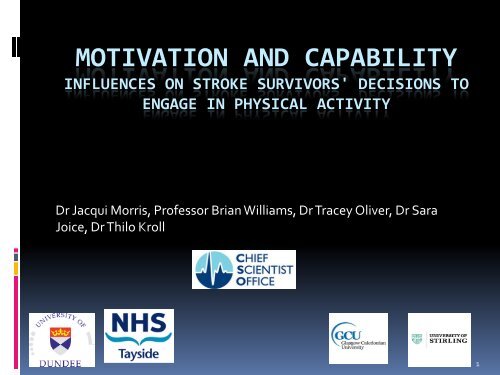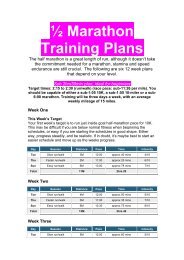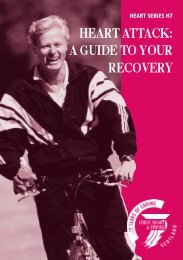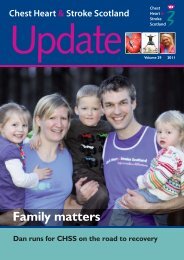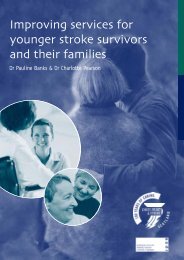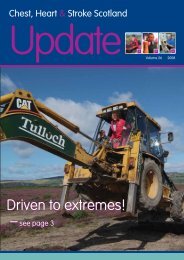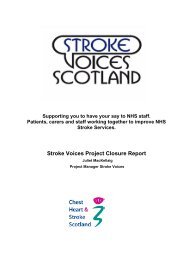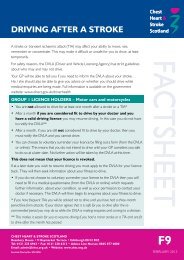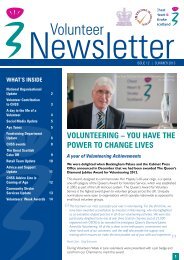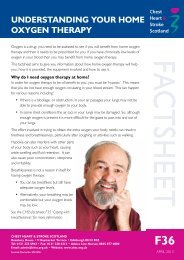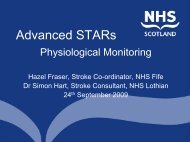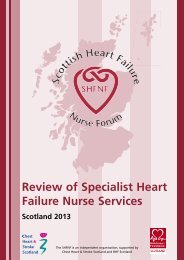Dr Jacqui Morris
Dr Jacqui Morris
Dr Jacqui Morris
Create successful ePaper yourself
Turn your PDF publications into a flip-book with our unique Google optimized e-Paper software.
MOTIVATION AND CAPABILITY<br />
INFLUENCES ON STROKE SURVIVORS' DECISIONS TO<br />
ENGAGE IN PHYSICAL ACTIVITY<br />
<strong>Dr</strong> <strong>Jacqui</strong> <strong>Morris</strong>, Professor Brian Williams, <strong>Dr</strong> Tracey Oliver, <strong>Dr</strong> Sara<br />
Joice, <strong>Dr</strong> Thilo Kroll<br />
1
Background<br />
• Benefits of engagement in physical activity post-stroke now established 1-9<br />
• Guideline recommendations for post-stroke exercise services 10-12<br />
However....<br />
• 58-68% of individuals with stroke undertake minimal physical activity<br />
• Ambulatory activity levels half of non-hemiplegic adults 14<br />
• Organised exercise classes benefits are lost at follow-up<br />
Suggesting....<br />
People are not managing or are choosing not to continue with physical activity<br />
9, 15<br />
13, 14<br />
2
Need to understand why<br />
• Previous qualitative studies - barriers and perceived benefits of<br />
physical activity 16-20<br />
• Urban environments, African Americans<br />
• Already participating in support or exercise groups<br />
• Unlikely to represent breadth of views and issues across range of sociodemographic<br />
populations<br />
3
Aim:<br />
To explore views and experiences of stroke survivors, to<br />
identify issues influencing physical activity participation<br />
after rehabilitation<br />
4
Methods<br />
• Design: Qualitative study, in-depth interviews<br />
• Population:<br />
Community dwelling stroke survivors >6 months after the end of<br />
rehabilitation<br />
• Purposive Sampling:<br />
• Disability (Barthel Index)<br />
• Deprivation (Carstairs Index)<br />
• Level of physical activity (PASIPD)<br />
• Recruitment: NHS Fife and Tayside via stroke liaison services, NHS<br />
rehabilitation services and exercise after stroke services<br />
• Data analysis: Framework Approach with constant comparison to<br />
derive conceptual themes and interpretation<br />
5
Topic Guide<br />
• Knowledge and beliefs about stroke and recovery<br />
• Knowledge and beliefs about physical activity<br />
• Beliefs and meanings relating to physical activity after<br />
stroke<br />
• Barriers and facilitators to physical activity<br />
6
Sample Characteristics (n=38)<br />
Male<br />
Female<br />
Gender 19 19<br />
Age: 20-60<br />
60-80<br />
80+<br />
Carstairs Deprivation Index :<br />
Low (mean = 0)<br />
High (high >0)<br />
3<br />
14<br />
2<br />
7<br />
12<br />
5<br />
12<br />
2<br />
10<br />
9<br />
Barthel Index: High disability (=100)<br />
Low Disability (
Physical activity after stroke<br />
8
Motivation<br />
Desire or intention<br />
Do they want to do it?<br />
9
Beliefs about stroke cause<br />
•Few beliefs<br />
•Lifestyle/medical<br />
Beliefs<br />
about cause<br />
and<br />
recovery<br />
“You don’t know. I wasn’t under any stress or<br />
anything like that...I was away at 3 o’clock in<br />
the morning. Didn’t seem to bother me, but I<br />
don’t know, but I don’t know how I got it. No I<br />
don’t” Male survivor, 74<br />
Attitudes<br />
to activity<br />
Motivation<br />
“I had a brain haemorrhage, I, that was, my<br />
type of stroke was a brain haemorrhage<br />
‘cause by high blood pressure.” (Male, 65)<br />
10
Stroke recovery beliefs<br />
• Few causal beliefs, natural process, little control<br />
• Clear causal beliefs, taking control over lifestyle for<br />
secondary prevention and physical recovery<br />
Beliefs<br />
about<br />
cause<br />
and<br />
recovery<br />
“well its just a matter of rest and simple, like I<br />
said they gave me simple exercises which I still<br />
do a bit you know...It is because, you see, I don’t<br />
know, when I had the stroke but I would say its<br />
just gradual isn’t it...” (Female 73)<br />
Attitudes<br />
to activity<br />
Motivation<br />
“....I was only 52 and I thought “Oh, hey,<br />
come on. Shake up and do something about<br />
it, improve what you did before, improve<br />
your fitness, improve your lifestyle”(Female<br />
survivor 69)<br />
11
Stroke recovery beliefs and<br />
physical activity<br />
• Low expectations for recovery, low control, low importance<br />
of PA<br />
• High expectations for recovery, high control, high<br />
importance of PA<br />
Beliefs<br />
about<br />
cause<br />
and<br />
recovery<br />
“There’s no elasticity left in my leg at all now, other than me lifting<br />
it up and down or whatever. I’ll never recover. I’ll only get<br />
worse. All I can do is try and keep as mobile as possible. I can’t<br />
really see exercise helping me recover from it.... (Male survivor,<br />
68)<br />
Attitudes<br />
to activity<br />
“It’s going to help me get back to a normal kind of<br />
standard of living.” (Female survivor 52)<br />
Motivation<br />
12
<strong>Dr</strong>ivers for recovery and attitudes<br />
to physical activity<br />
• Few recovery drivers, low prioritisation<br />
• Strong drivers of recovery, family, social, work,<br />
prioritisation of PA<br />
<strong>Dr</strong>ivers<br />
for<br />
recovery<br />
Attitudes<br />
to activity<br />
Motivation<br />
“I just let every day go by, take the day as it<br />
comes”. (Male, 83)<br />
Well … one of the psychological things in my brain, I, was<br />
I need to be, get better for my wife and my family ‘cause<br />
they need me … they do, they do em, so I, you know that<br />
was at the back of my mind as well and I want to see my<br />
grandchildren growing up and I want, you know I, I, that<br />
was a real driving force for me, think of the reasons why<br />
you want to live, or you want to do something (Male<br />
survivor 65)<br />
13
Physical activity after stroke<br />
14
Capability<br />
Translation of intentions into action<br />
Do they think they can do it?<br />
15
Barriers: negative effects on perceived<br />
capability<br />
Effects of stroke and<br />
co-morbidities<br />
• Physical effects<br />
• Fatigue<br />
• Communication<br />
• Emotional effects/mood<br />
• Fear – falling, recurrence<br />
• Embarrassment<br />
• Age, co-morbidities<br />
Environmental Factors<br />
• Transport availability<br />
• Transport accessibility<br />
• Knowledge of opportunities<br />
• Timing<br />
• Cost<br />
• Weather<br />
Perceived Capability<br />
16
Facilitators<br />
• Support from others<br />
• Family:<br />
Facilitatory<br />
Directive<br />
Over protective<br />
• Other survivors<br />
• Health professionals<br />
“So, they know now to let me, though I stand<br />
and struggle, just about swear and I’ll say, ‘Look<br />
I’ll have to give up on this, I cant get this zip in<br />
properly to zip it up.’. I try and persevere and<br />
they know that and the family know that now<br />
as well, the girls will say, ‘Right, we’ll leave you.<br />
I could do this for you mum. Do you want to do<br />
it for yourself?’ and I’ll say, ‘Look, let me try and<br />
if I can’t manage it, I’ll ask you to do it.’”<br />
(Female, 70)<br />
Perceived<br />
Capability<br />
Support from others<br />
“Everyone that’s up there has got something wrong with them<br />
so you don’t feel sort of....you just don’t feel out of place<br />
because everybody’s in the same position you know....gives<br />
you encouragement because you think well if Neil can do that<br />
I can do that, because he is a third my age....” (Female<br />
survivor, 75)<br />
17
Facilitators of activity<br />
• Self-determination despite effects of stroke<br />
• Overcome barriers<br />
Motivation<br />
Sheer bloody mindedness!...I will not be<br />
beaten…Well, you can be so sore<br />
sometimes. You’re in agony but you’ve<br />
just got to keep pushing on through it.”<br />
(Female stroke survivor, 44)<br />
Perceived<br />
Capability<br />
Self- determination<br />
“Because I want to get better and I think<br />
that’s where the determination comes<br />
from, the fact that you want to get better<br />
so you do the things you’re supposed to<br />
do in the hope that they will work.” (Male<br />
stroke survivor, 78)<br />
18
Experiences and self-efficacy<br />
• Effortful, negative, undermining confidence<br />
• Positive, contributing to recovery<br />
Motivation<br />
Perceived<br />
Capability<br />
Self-efficacy<br />
Experiences<br />
“I couldn’t do it and I did it all wrong and I went and<br />
hurt myself on it. I hurt my back. So that was the end<br />
of the Wii. It just sits there unless somebody comes to<br />
have a game on it. I can’t do it” (Female survivor 68)<br />
“You’re maybe just walking down the road and you think ‘Oh<br />
that was a wee bit easier walking down there’, or rather than<br />
take 15 minutes you realise you’ve done it in 10 minutes...you<br />
think ‘oh I am getting better after all and then it just spurs you<br />
on again” (Female, 43)<br />
19
Frustration<br />
• Dissonance between capability and motivation<br />
There’s days I think frustration gets to you. I often<br />
say, ‘The stroke didn’t kill me, but frustration will.’<br />
Whoever develops a pill for frustration will make a<br />
bloomin’ million.” (Female stroke survivor, 43)<br />
Motivation<br />
Perceived<br />
Capability<br />
“I’ve stopped going to Scottish Old time dancing<br />
because I can’t do it properly and I used to be in a<br />
Scottish country dance team where I did it<br />
properly and it just frustrates me that I can’t do it<br />
properly. The same with tap dancing....so I’ve<br />
stopped doing that.” (Female 69)<br />
20
Physical activity after stroke<br />
F<br />
r<br />
u<br />
s<br />
t<br />
r<br />
a<br />
t<br />
i<br />
o<br />
n<br />
21
Conclusions<br />
• Adoption of physical activity after stroke is complex<br />
• Decisions to be active appear to depend on stroke and recovery<br />
beliefs and recovery drivers, influenced by motivation and<br />
perceived pragmatic facilitators and barriers<br />
• Beliefs about stroke cause, recovery and physical activity are<br />
modifiable and should be targeted<br />
• Provides a stroke specific model of interactions, may assist in<br />
development of interventions<br />
• Theoretically relevant behaviour change interventions should be<br />
applied combined with pragmatic steps to address barriers<br />
• Timing and context requires further investigation<br />
22
References<br />
1. Brazelli M, Saunders DH, Greig CA, Mead GE, Young A. Physical fitness training for stroke patients. Cochrane Database of<br />
Systematic Reviews 2009, Issue 4. Art. No.: CD003316. DOI: 10.1002/14651858.CD003316.pub3.<br />
2. Wevers L, van de Port I, Vermue M, Mead G, Kwakkel G. Effects of Task-Oriented Circuit Class Training on Walking<br />
Competency After Stroke A Systematic Review. Stroke. 2009 Jul;40(7):2450-9.<br />
3. Cramp MC, Greenwood RJ, Gill M, Lehmann A, Rothwell JC, Scott OM. Effectiveness of a community-based low intensity<br />
exercise programme for ambulatory stroke survivors. Disabil Rehabil. 2010;32(3):239-47.<br />
4. Lennon O, Carey A, Gaffnet N, Stepheenson J. A pilot randomized controlled trial to evaluate the benefit of the cardiac<br />
rehabilitation paradigm for the non-acute ischaemic stroke population. Clinical Rehabilitation 2008; 22: 125-33<br />
5. Rimmer J, Rauworth A, Wang E. Nicola T, Hill B A Preliminary Study to Examine the Effects of Aerobic and Therapeutic<br />
exercise on Cardiorespiratory Fitness and Coronary Risk Reduction in Stroke Survivors. Arch Phys Med Rehabil 2009; 90:407-<br />
12.<br />
6. Stuart M. et al. Community-Based Adaptive Physical Activity Program for Chronic Stroke: Feasibility, Safety, and Efficacy of<br />
the Empoli Model. Neurorehabil Neural Repair 2009; 23: 726-734<br />
7. Yang R et al.Task-oriented progressive resistance strength training improves muscle strength and functional performance in<br />
individuals with stroke Clinical Rehabilitation 2006; 20: 860870<br />
8. Carin-Levy G, Kendall M, Young A, Mead G. The psychosocial effects of exercise and relaxation classes for persons surviving<br />
a stroke. Can.J.Occup.Ther. 2009 April;76(2):73-80.<br />
9. Mead G GC, Cunningham I, Lewis SJ, Dinan S, Fitzsimons C. A STroke: A Randomised Trial of Exercise or Relaxation<br />
(STARTER] Journal of the American Geriatrics Society 2007;55:892-9.<br />
10. Gordon NF. Gulanick M. Costa F. Fletcher G. Franklin BA. Roth EJ. Shephard T Physical activity and exercise<br />
recommendations for stroke survivors. Stroke 2004 May;35(5):1230-1240.<br />
11. Guidelines for community based exercise programs after stroke working group: Guidelines for community based exercise<br />
programs after stroke. Endorsed by Ontario Stroke Network 2010<br />
12. Best Practice Guidance for the Development of Exercise after Stroke Services in Community Settings . Best C., Van Wijck F,<br />
Dinan S et al. University of Edinburgh 2010.<br />
13. Shaughnessy M, Resnick BM, Macko RF. Testing a model of post-stroke exercise behavior. Rehabil Nurs 2006;<br />
31:15-21<br />
23
References<br />
14. K. M. Michael, J. K. Allen, and R. F. MacKo, “Reduced ambulatory activity after stroke: the role of balance, gait, and cardiovascular<br />
fitness,” Archives of Physical Medicine and Rehabilitation, vol. 86, no. 8, pp. 1552–1556, 2005.<br />
15. Mudge S, Barber PA, Stott NS. Circuit-Based Rehabilitation Improves Gait Endurance but Not Usual Walking Activity in Chronic<br />
Stroke: A Randomized Controlled Trial. Archives of Physical Medicine and Rehabilitation. 2009;90(12):1989-96.<br />
16. Damush T, Plue L et al. Barriers and facilitators to exercise among stroke survivors. Rehabilitation Nursing; 32, 253<br />
17. Rimmer JH et al 2008. Barriers associated with exercise and community access for individuals with stroke. Journal of Rehabilitation<br />
Research and Development; 45: 315-322<br />
18. Reed M, Harrington R, Duggan A, Wood V . Meeting stroke survivors’ preceived needs: a qualitative study of community based exercise<br />
and education scheme. Clinical Rehabilitation 2010; 24: 16-25<br />
19. Sharma H, Bulley C, Van Wijck F. Experiences of an exercise referral scheme from the perspective of people with chronic stroke: A<br />
qualitative study. Physiotherapy 2012; 98: 341-348<br />
20. Simpson LA, Eng, J, Tawshy A. Exercise perceptions among people with stroke: Barriers and facilitators to participation. International<br />
Journal of Therapy and Rehabilitation 2011; 9: 520-530<br />
24


